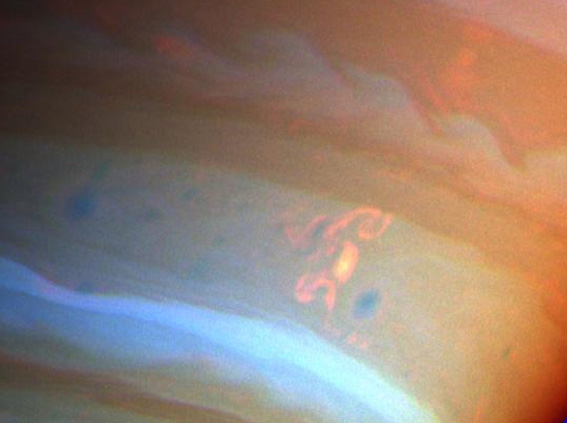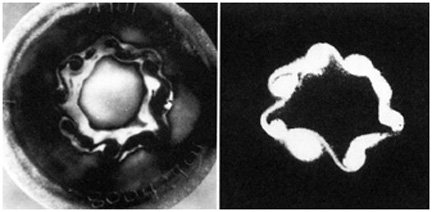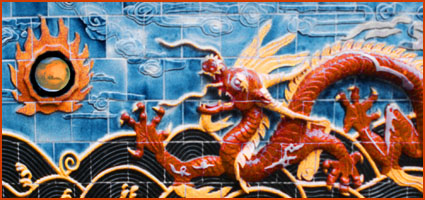holoscience.com | The ELECTRIC UNIVERSE®
A sound cosmology for the 21st century

The Dragon Storm
A news item headlined “The Dragon Storm” appeared on the Cassini mission website on February 24.

The imagery of the celestial dragon in this context is an unconscious nod to an electrified universe. The new science of plasma behavior emphasizes the dominant role of the electric force and its powerful effects in the electrically charged matter that makes up 99 percent of the universe. Plasma science is re-writing the textbooks on galactic, stellar, and planetary evolution. And it throws new interdisciplinary light on the ancient “doomsday” dramas involving a celestial dragon and the “thunderbolt of the gods.” This dragon storm on Saturn connects the modern science with the ancient dramas.
A few thousand years ago, ancient artists around the world carved similar complex images on stone. The meticulous research of plasma scientist Anthony Peratt, a leading authority on the forms taken by high-energy electrical discharges in plasma, has confirmed that these images pictured heaven-spanning forms seen in the ancient sky. Stories and rituals in all ancient cultures, memorializing a catastrophe that involved heaven-shattering battles of planetary “gods” and monsters, parallel these images. Most common is the story of the fiery serpent or dragon attacking the world.
Such archetypal images seem to be burned into our collective subconscious. For example, ringed planets often feature in a young child’s primitive drawings about space. Yet they have no experience of them. In the same way, scientists seem unconsciously to draw on archetypes. And the results are often equally surprising.
The ELECTRIC UNIVERSE® model may explain the connection between the dragon of legend and the storm seen in this image. But first we should hear what Cassini mission scientists had to say:
A large, bright and complex convective storm that appeared in Saturn’s southern hemisphere in mid-September 2004 was the key in solving a long-standing mystery about the ringed planet. The Dragon Storm was a powerful source of radio emissions during July and September of 2004. The radio waves from the storm resemble the short bursts of static generated by lightning on Earth. Cassini detected the bursts only when the storm was rising over the horizon on the night side of the planet as seen from the spacecraft; the bursts stopped when the storm moved into sunlight. This on/off pattern repeated for many Saturn rotations over a period of several weeks, and it was the clock-like repeatability that indicated the storm and the radio bursts are related. Scientists have concluded that the Dragon Storm is a giant thunderstorm whose precipitation generates electricity as it does on Earth. The storm may be deriving its energy from Saturn’s deep atmosphere.
One mystery is why the radio bursts start while the Dragon Storm is below the horizon on the night side and end when the storm is on the day side, still in full view of the Cassini spacecraft. A possible explanation is that the lightning source lies to the east of the visible cloud, perhaps because it is deeper where the currents are eastward relative to those at cloud top levels. If this were the case, the lightning source would come up over the night side horizon and would sink down below the day side horizon before the visible cloud. This would explain the timing of the visible storm relative to the radio bursts.
The Dragon Storm is of great interest for another reason. In examining images taken of Saturn’s atmosphere over many months, imaging scientists found that the Dragon Storm arose in the same part of Saturn’s atmosphere that had earlier produced large bright convective storms. In other words, the Dragon Storm appears to be a long-lived storm deep in the atmosphere that periodically flares up to produce dramatic bright white plumes which subside over time. One earlier sighting, in July 2004, was also associated with strong radio bursts. And another, observed in March 2004 and captured in a movie created from images of the atmosphere (PIA06082 and PIA06083) spawned three little dark oval storms that broke off from the arms of the main storm. Two of these subsequently merged with each other; the current to the north carried the third one off to the west, and Cassini lost track of it. Small dark storms like these generally get stretched out until they merge with the opposing currents to the north and south.
These little storms are the food that sustains the larger atmospheric features, including the larger ovals and the eastward and westward currents. If the little storms come from the giant thunderstorms, then together they form a food chain that harvests the energy of the deep atmosphere and helps maintain the powerful currents.
Cassini has many more chances to observe future flare-ups of the Dragon Storm, and others like it over the course of the mission. It is likely that scientists will come to solve the mystery of the radio bursts and observe storm creation and merging in the next 2 or 3 years.
Credit: NASA/JPL/Space Science Institute
Calling the dragon storm “a giant thunderstorm whose precipitation generates electricity as it does on Earth” explains nothing. The generation of lightning on Earth remains a mystery to meteorologists. It is thought to derive from vertical movement of droplets in a thundercloud “in a way or ways not yet fully understood” [Lightning, Martin A. Uman, Dover Publications]. Hence the notion that “the storm may be deriving its energy from Saturn’s deep atmosphere.” As discussed elsewhere on this website, thunderstorms are electric discharge phenomena driven by the circuits that link planets to stars and stars to the galaxy. The electrical effects at Saturn have already been outlined in an earlier ELECTRIC UNIVERSE® news item.
The report does not discuss the complex shape of the dragon storm. But that shape indicates an external origin of electrical power. Similar forms occur in plasma instabilities when an intense beam of electrons strikes a ‘witness plate.’

These two images show in cross-section what happens to a beam of electrons that is following an axial magnetic field. The image on the left is due to a 90 kiloamp current striking a carbon witness plate. The other image is due to a 58 microamp current striking a fluorescent screen. So in the laboratory the effect is scaleable over 12 orders of magnitude of beam current!
The same effect occurs in the Birkeland currents that drive the aurora on Earth and is responsible for the undulating auroral curtains. Scaling up from the size of Earth’s auroras to the storm on Saturn is no problem. The two prominent “spiral galaxy” formations in the dragon storm are likely the effects of the interaction of Birkeland current pairs. In other words, plasma phenomena may be scaled up from the laboratory to planetary, and even to galactic, dimensions.
Like Jupiter’s Great Red Spot, the dragon storm on Saturn seems to be a long-lived storm center that occasionally flares up. The clock-like regularity of the radio emissions from storms on Saturn is used to judge the great planet’s actual rotation rate beneath the clouds. But this behavior is enigmatic. Why should an electrical storm attach itself to a particular spot on a planet’s surface, particularly when that surface is thought to be liquid?
The ELECTRIC UNIVERSE® model of stars and planets provides the possibility of a solid surface on the giant planets. And as we find on Earth, a solid surface allows for regional electrical differences that favor electrical storm activity in one region over another. A good example is “tornado alley” in the southern U.S.A.
The ELECTRIC UNIVERSE® accepts the plasma cosmology version of star formation, which postulates that a star is formed in a ‘z-pinch’ in a galactic electric discharge. It is a model that can be shown experimentally to work. In contrast, the gravity cosmology version, which postulates that a star is formed by the collapse of a cloud of gas, cannot be demonstrated experimentally nor can a collapsing cloud be identified observationally. Furthermore, this ‘nebular theory’ is beset with theoretical contradictions of angular momentum and magnetic field distribution.
In the ELECTRIC UNIVERSE®, stars do not “consume themselves” to fuel their radiant output. The same galactic currents that formed them remain to light them. This means that stars are born electron deficient with respect to their galactic environment. It also means that galaxies be born similarly electron deficient with respect to their environment. It is the slow galactic charging process that maintains the steady glow of their countless starry electric lights.
Early in the Twentieth Century astronomers dismissed the notion of an external power source for stars because they thought a star would swiftly collapse under its own weight unless there was a central source of radiation pressure to prevent it. But this argument fails if charge separation occurs in massive bodies. This possibility of charge separation was considered, but it was discarded by arguing, using the ideal gas laws, that the light electrons would not rise to the top to any significant degree in a hydrogen atmosphere.
This is a prime example of an inappropriate model rendering all further theorizing worthless. The physicists would have been well advised to look to the chemists for a better model – one in which the electric dipole force between atoms and molecules plays a dominant role. Because the atoms in a strong gravitational field will be distorted, the heavy positively charged nucleus will be offset from the center of the atom toward the center of the star. The result is that each neutral atom becomes a small radial electric dipole. The effect on free electrons is to cause them to drift toward the surface, leaving positively charged ions behind in the interior. The repulsive forces among these positively charged ions prevent the gravitational collapse of the star.
Furthermore, the visible “surface” of a star, or photosphere, is an electric discharge phenomenon and therefore not controlled by gravity. The standard model of stars assumes that gravity and radiation pressure determine the size of a star. That is not so in the electrical model. So conventional calculations of the density of stars and their internal composition have no real meaning.
But there is more. Physicists assume that Newton’s law of gravity has a “universal” gravitational constant, “G,” which is the same for all bodies in the universe. But “G” is the most elusive constant in physics. It seems to be different every time the same apparatus measures it on Earth. The ELECTRIC UNIVERSE® takes a different view. “G” depends on the internal electric stress of the body and is different for every body in the universe. This effect can be seen in particle accelerators where matter apparently gains in mass in response to the amount of electrical stress that is applied to it.
So deducing the composition and structure of stars and planets by measuring their gravitational fields and assuming “G” to be a fixed value will give misleading results. Conventional models assume planets are accreted from a hypothetical primordial solar nebula. They also assume that hydrogen is compressed to a metallic state in the cores of gas giants. These assumptions too are invalid in an ELECTRIC UNIVERSE®.
Planets are “born” fully formed from larger bodies. They are not accreted. The process of having planetary “children” is that of electrical expulsion of a part of the positively charged matter from beneath the surface of a disturbed star or gas giant. That is why the gas giants have satellite systems that are like miniature solar systems. The British physicist Peter Warlow was moved to write:
All of the existing theories of planet formation have taken material from the surface of the Sun or from a cloud of dust outside the Sun in order to form the planets, for the ‘obvious’ reason that planets are on the outside of the Sun. We humans, equally ‘obviously,’ are outside our mothers – yet we did not start there.”
[The Reversing Earth, 1982].
Some measure of the internal composition of stars can be seen in their “children” – the gas giants. But all we can see and measure is the upper atmospheres and clouds of the gas giants. To delve deeper we need to look at the “children” of gas giants – the rocky planets and moons. Clearly, each planet and moon may have a complex history. All were not formed at about the same time in a single event. And the larger bodies must have evolved discontinuously with each birth. So it was with Saturn!
The ancients knew Saturn as “the Sun of night.” The archaic words we now associate with the Sun—Ra, Helios, Shamash, etc.—originally referred to Saturn. Saturn’s core is still hot (Saturn radiates more than twice the energy that it receives from the Sun) because of Saturn’s recent history as a radiant body. This suggests that beneath Saturn’s clouds is a large, hot, solid body practically indistinguishable in composition and physical state from Venus or Earth. Its positively charged core prevents hydrogen from being compressed to the metallic state. With a solid core and having “given birth” fairly recently – as evidenced by the ephemeral icy rings – Saturn probably still bears the birth scar, hidden beneath the clouds. We might expect some preference for continued electric discharge from that scarred region.
Saturn is the most oblate planet in the solar system. Its equatorial winds are four times faster and the “jets” twice as wide as Jupiter’s. These factors suggest an atmosphere of great depth. This may explain why the radio noise associated with the dragon storm seems to precede the storm. The tornadic discharge to the surface of Saturn must be skewed over a considerable distance by the high-speed winds and great depth of the atmosphere. Only the powerful electromagnetic forces that control a tornadic discharge could maintain the integrity of the discharge column under the onslaught of tremendous vertical wind shear. (The winds in the upper atmosphere have been estimated to exceed 1000 mph.)
The ELECTRIC UNIVERSE® model provides a connection between the dragon of legend and the storm seen in the Cassini image. The model was built, not from theoretical considerations alone but from an interdisciplinary inquiry into the images of planets (represented as disks) and cosmic plasma phenomena that our ancestors felt were so important to remember. They chiselled millions of uniquely diagnostic patterns, known as petroglyphs, into solid rock. But with the context long gone, these petroglyphs have become a mere curiosity.
Meanwhile the physical clue for an intimate relationship in the past between Saturn, Mars and Earth lies in their similar axial tilts of 26˚, 24˚ and 23˚. The axis of a rapidly spinning planet has a gyroscopic stability that resists change due to external forces. The normal result of disturbance is merely to cause the axis to slowly precess.

The first civilizations sprang up in reaction to the dramatic prehistoric events. The activities of those civilizations—their organization, art, architecture and rituals—were directed toward the memorialization of the former celestial drama. It is there we first meet the inexplicable, capricious planetary gods and the world-threatening, fire-breathing celestial dragon or serpent. So it is fitting that scientists today should unconsciously associate the dragon image with a powerful plasma discharge on Saturn. However, the connection will only become consciously apparent when the electrical nature of the universe is acknowledged. Only then may scientists solve the mysteries of Saturn’s dragon storm.
Wal Thornhill